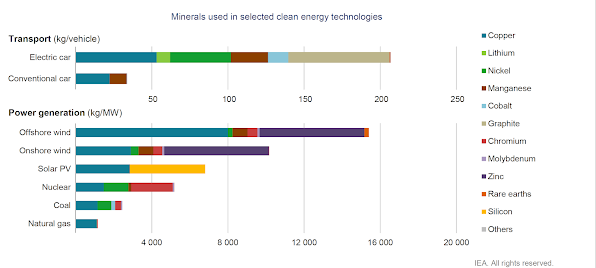Critical Mineral's Role & Clean Energy Transition (Part 1)
A picturesque view of Saturn’s ring brings forth the dystopian view from Star Wars where universe is ruled by a power-hungry autocrat, seeking to rein supreme on mundane people. An eclectic range of view dilutes in mind that oozes feelings of colourful sunny days along a serene coastal beach. But as we dream of sunny days how much are we conscious about monotonous, tedious jobs of searching vast deposits of minerals in earth’s crust or elsewhere, maybe in space? The dystopian landscapes, portrayed in star wars, might be a clue to where we are headed in not-too-distant future where critical minerals that props up our daily life runs dry? So let’s dive in to a sojourn for what might be forthcoming Armageddon on Critical Supply of Minerals that is the spinal chord of human civilisation.
Note: kg = kilogramme, MW = megawatt
Emerging energy sector, for example, solar panels, wind turbines, geothermal energy, bioenergy etc., are beginning to chip away bigger and bigger chunks of minerals required. For battery it is lithium, nickel, cobalt, manganese and graphite etc. whereas wind turbine and EV motors require magnets that is produced from rare earth minerals.
2020 A PIVOTAL YEAR
COVID-19 flipped the switch of urgency in us as to what is important and what is worth paying attention for with mirror and reminded us of dire sensitivity to a unidentified viral disease. The same year painted a pivotal transition year for clean energy.
Rapid increase of mineral demand across transport sector shows that compared to conventional cars electrical cars requires at least 6 times more minerals. In terms of power generation, solar PV requires almost 2.5 times more minerals than conventional coal-fired power.
As we transition to more sustainable power generation so does mineral consumption across the board.
Note: STEPS = Stated Policies Scenario, SDS= Sustainable Development Scenario by material types.
Unexpected Consequences
Mineral demand due to uptake of clean energy technologies would rise by atleast four times by 2040 if we were to meet climate goals. The unimaginable increase in mineral demand varies from 20 to 40 times the current need. Biggest contributor being EVs and battery storage which uses lithium (increase by 40 times), graphite (increase 20-25 times), cobalt (increase 20-25 times) and nickel (increase 20-25 times) etc. The hidden background demand in terms of rapid deployment of networks in remote community and upgrading in urban areas means increase in copper demand as well.
Note: Mt = Million Tonnes
When we compare current trends of mineral consumption for coal against sustainable transition the picture becomes apparent when compared to 2020 baseline values.
Is Recycling the saviour?
To transition into sustainable future, recycling will play a pivotal role by preserving the critical supply of minerals in circular economy. Cost efficient technologies to recycle lithium and rare earth minerals are still in its nascent stage and vast amount of research and investment is needed to make other minerals reusable. Even by most optimistic estimate recycling is only predicted to contribute 10% of whole supply chain by 2040. This is not only insufficient but must be increased to capture atleast 90% of raw original minerals to make viable impacts on supply chain.








Comments
Post a Comment